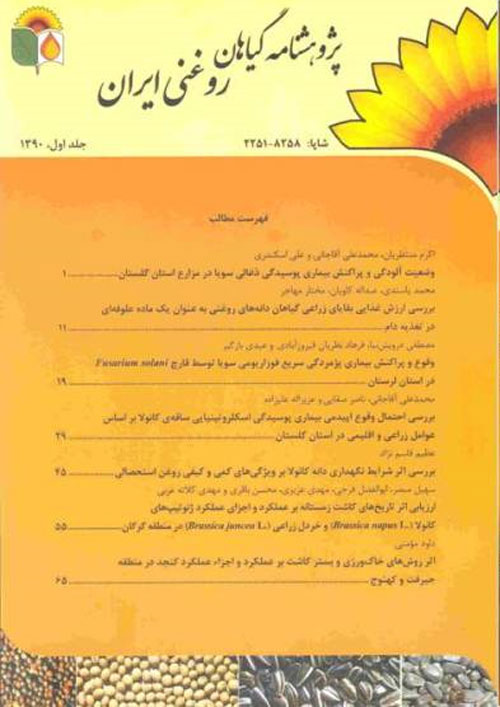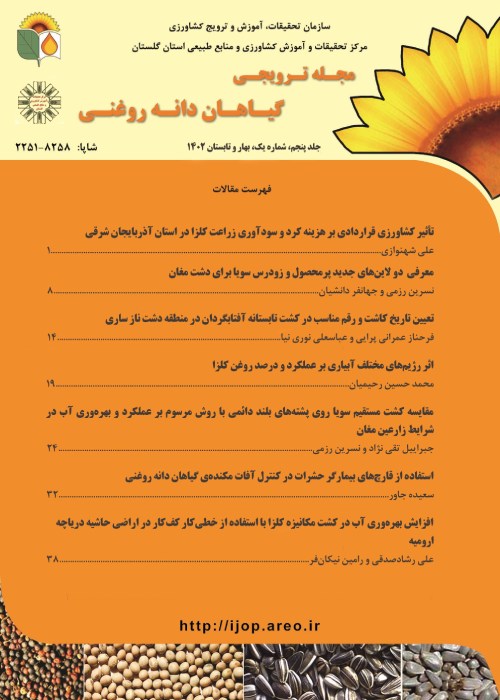فهرست مطالب

نشریه گیاهان دانه روغنی
شماره 1 (1390)
- تاریخ انتشار: 1390/06/20
- تعداد عناوین: 7
-
Page 1Charcoal rot, caused by fungal species Macrophomina phaseolina, is one of the most important diseases of soybean in north of Iran and in some years, it causes great damage to the crops. In order to determine the infection in different regions of Golestan province, soybean fields were surveyed during November and December of 2009, and disease incidence (I) and severity (S) via dividing the height of infected stem by total stem height were recorded. Statistical analysis of collected data revealed that there is a significant difference for I and S between regions and fields under study. Results of the mean comparisons using Duncan multiple range test revealed that fields of region Aliabad and Azadshahr regions had the highest and lowest I, with 40 and 0.09 %, respectively. The maximum and minimum values of S was observed in Aliabad and Azadshahr, with 11 and 2.5 %, respectively. The mean value of I in the studied fields was 21.24% and mean severity of disease was 6.7%.Keywords: Golestan province, Soybean, Charcoal rot, Macrophomina phaseolina, Disease incidence, Disease severity
-
Page 11Two studies were performed to assess the chemical composition and to determine in vivo digestibility of soybean straw (SS), rape straw (RS) and sunflower straw (SFS) in Golestan Province. First experiment was carried out using 23, 21 and 9 samples for SS, RS and SFS, respectively. The chemical composition of samples was determined using AOAC procedures. In the second experiment, apparent digestibility of straws was determined by in vivo method using 4 mature Dalagh breed sheep. Data were analyzed by t-test. The results showed that the Crude protein (CP) content of SS, RS and SFS were 4.8, 3.9 and 5.6 percent, respectively And there were significant difference between them at 0.05 probability level. SFS and SS had the highest (%2.45) and lowest (%0.82) EE, respectively. Crude fiber (CF) content of them was 46.1, 45.6 and 35.90 percent, respectively. Organic matter (OM) content varied from %94 in SS to %80.6 in SFS. Calcium (Ca) and Phosphorus (p) concentration were highest in SS (1.36 and 0.32 percent, respectively); and Potassium (K) concentration was highest in SFS (%2.45). Iron(Fe) content in SS, RS and SFS were 183.5, 260 and 214.6 mg/kg, respectively. Digestibility coefficients of DM, CP, EE, CF and OM in straws varied between 41.5-49.6, 12.4-28.3, 44.5-47.6, 39.1-44.2 and 42.1-45.2 percent, respectively and metabolism energy varied between 1.34-1.38 McCall/kg,. The result showed that straws were high in CF and inclusion of high CF straws can cause the reduction of digestibility of dry matter in sheep.Keywords: Chemical composition, Digestibility, Soybean straw, Rape straw, Sunflower
-
Occurrence and distribution of soybean sudden death syndrome by Fusarium solani in Lorestan provincePage 19Soybean (Glycin max L.) belongs to the legume family. It is used as cooking oil, margarine, shortening, salad dressings, soybean meal and it is a source of protein for human as well as livestock consumption. Soybean contains all essential amino acides except lysine. According to latest results, soybean products reduce blood cholesterol and consequenty decreases the risk of heart diseases.Samples were collected from soybean fields of Alashtar and Chaghalvandy during 2004- 2006 Cropping years. Collected samples were transferred to the laboratory and cultured on Nash and Snyder and general PDA media. One hundred and forty seven fungal isolates belonging to Fusarium genus were isolated. Two species namely Fusarium solani and F. equiseti with 98% and 2% frequencies were recognized, respectively. Pathogenisity of F. solani on soybean plants in the green house was confirmed using chlamydospore inoculum. Analyses data using MSTAT-C software and duncan multiple range test of means showed that F. sloani pathogenisity was significant (P<0.01). This disease is reported from Iran and Lorestan province for the first time.Keywords: Soybean, Sudden death syndrome (SDS), Fusarium solani, Lorestan province
-
Page 29Sclerotinia stem rot (SSR), caused by Sclerotinia sclerotiorum, is the most important diseases of canola (Brassica napus) in Iran. In order to collect necessary data for disease forecasting, 80 fields were selected in four regions of Golestan province (Gorgan, Ali Abad, Kalaleh and Gonbad) in north of Iran, and disease amount (incidence and mean severity) was recorded weekly during two growing seasons (2006 and 2007). For predicting epidemic based on field and climatic variables, canola growing season was divided to 3 durations: planting to flowering onset, flowering to first symptoms appearance, and first symptoms to the end of the epidemic. Correlations of 95 cultural and climatic factors with epidemic was studied by logistic regression and discriminate analysis. Of nine developed models, three of them for each of the periods, had a sufficient validity for predicting epidemics, and they were comprised of different variables of temperature, relative humidity, number of rainy days and evaporation, besides the amount of utilized N fertilizer (as Urea).
-
Page 45The high demand of vegetable oil and the dependence of country on this product are clear. The deficit in processing companies and infrastructures, high volume of product during harvest time as well as limited information caused us to perform an experiment to study the effect of storage time and storage conditions on the quality and quantity of canola seed oil. A factorial experiment based on a completely randomized design containing two factors: storage time (zero, 1, 2, 3 and 4 month) and storage temperature (4, 21, 35 C°), with 4 replications was performed. Results showed that regardless of storage conditions, seed oil decreased by increasing storage duration. At the end of storage time oil reduction was 1.1% of the control (46.1%). Temperature had no significant effect on seed oil content (45.8% and 45.6% at 4 and 35 0C, respectively). Investigation of the changes of esterified fatty acids and the content of free fatty acids showed that their concentration was strongly related to the storage conditions. Free fatty acid content and the amount of peroxide value which are two important quality indices of oil, increased by increase in temperature. Free fatty acid content increased from 2.1% at the beginning of experiment to 5.1% at the end of experiment. The results showed the inverse relationship of oil quality and quantity reduction with storage time; the rate of reduction increased with an increase in temperature. Thus the shortening of the time from seed harvesting to oil extracting and processing, besides the controlling of the qualitative and quantitative properties might increase the stability of product during marketing and consumption. Based on the physiological properties of canola seed, the time from harvest to oil extraction is very important and it is advised to reduce this time as short as possible. Although no significant effect of temperature was observed on seed oil percentage, high temperature can increase the amount of free fatty acid and peroxide which are directly related to oil quality. Thus to keep oil quality and to increase oil extraction efficiency, it is recommended to store seed lots under low temperatures and shorten the waiting time from harvest to processing (maximum two months).Keywords: Oil peroxide, Free fatty acid, Ecosanoic acid, Canola seed, Storage conditions
-
Page 55In order to evaluate the effect of winter sowing dates on yield and yield components of canola (Brassica napus L.) and mustard (Brassica juncea L.), an experiment was conducted at the Agricultural Research Station of Gorgan during 2009. The experiment was a spilt plot design, arranged in an RCBD with 3 replications. Four sowing dates (January 5, 20 and February 5, 20) were main plots and four genotypes Hyola 401, RGS003 (canola) and Bard1 and J98 (mustard) were sub plots. The results showed that delay in sowing date significantly decreased the number of pods per plant, the number of seed per pods, 1000-seed weight and seed yield. First sowing date had the highest seed yield (2407 Kg/ha) and fourth sowing date had the lowest seed yield (1054 Kg/ha). The number of pods per plant in mustard genotypes was more than that of canola genotypes.However the number of seeds per pod, 1000-seed weight and seed yield of canola genotypes were more than those of mustard genotypes. Hyola 401 had the highest number of seeds per pod, 1000-seed weight and seed yield.Based on the results of the experiment when sowing date is delayed and condition is not favorable for autumn sowing it is recommended to sow Hyola 401 in January 5.Keywords: Sowing date, Canola, Mustard, Gorgan
-
Page 65To study the tillage and planting methods effects on yield and yield components of sesame, this experiment was conducted in an RCBD arrangement in a split plot with 3 replications in Jiroft region for 3 years. Main plots were: a) conventional tillage, b) minimum tillage, c) conservation tillage and d) no tillage. All plots were shallowly tilled with a harrow disk two days prior planting. Sub plots (planting methods) were: a) ridge planting, b) furrow planting c) flat planting. The effects of tillage methods on yield were significant at P=0.05, so that the lowest and highest yield were obtained in conventional tillage (1222.7 Kg/ha) and minimum tillage (1832.2 Kg/ha), respectively. Tillage methods had significant effect on pod number and the 1000 seeds weight in the first year and on the number of pods in second and so that the least in third year. The effect of different bed pattern on yield was also significant at P=0.05, so that the lowest yield (1306.7Kg/ha) was produced in the treatment “a” and the highest one (1780.9 Kg/ha) in the treatment “c”. The pod number per plant and height of the lowest pod from the ground were affected by bed pattern in the first year while in the second and third year only pod number was affected. Therefore the treatment “c” had the highest yield. Tillage methods and Planting patterns did not have any effect on traits such as stem diameter, plant height and reproductive stems numbers.Keywords: Conservation tillage, Conventional tillage, Minimum tillage, No tillage, Sesame, Yield


